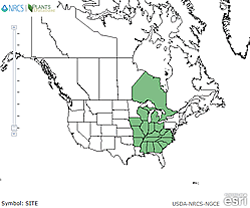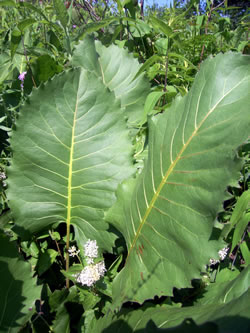Plant of the Week
 Silphium terebinthinaceum range map. USDA PLANTS Database.
Silphium terebinthinaceum range map. USDA PLANTS Database.
 Prairie dock (Silphium terebinthinaceum) flower. Photo by Christopher David Benda.
Prairie dock (Silphium terebinthinaceum) flower. Photo by Christopher David Benda.
 Prairie dock (Silphium terebinthinaceum) leaves. Photo by Christopher David Benda.
Prairie dock (Silphium terebinthinaceum) leaves. Photo by Christopher David Benda.
Prairie Dock (Silphium terebinthinaceum)
By Christopher David Benda
Prairie Dock is a neat plant in the Aster family (Asteraceae). The name “Silphium” refers to an ancient Greek plant that produces resin. Resin was once highly sought after for a variety of uses, including as an incense for use in religious ceremonies. The species name “terebinthinaceum” means “like turpentine,” referring to the odor of this plant.
This herbaceous perennial plant has very large leaves that are primarily basal and rough to the touch, with heart-shaped leaf bases and course teeth along the margin. Like the related compass plant, the leaves of prairie dock tend to orient in a north-south direction. That is, the broad part of the blade faces east and west, to maximize sunlight for photosynthesis. This adaptation also minimizes water loss due to transpiration. Feel the leaves in the midsummer and they will feel cool to the touch.
This is a very tall perennial plant, with a nearly leafless flower stalk, sometimes over eight feet tall. Not only does the plant extend high into the air, it also has a long taproot that grows deep into the soil. This adaptation is beneficial because the prairie is often hot and dry, and the deep taproot allows the plant to reach water. This feature also helps the plant persist despite grazing and mowing. With so much energy reserves stored underground, sending up new shoots is not that costly for the plant. Although definitive studies are lacking, this is believed to be among the longest-lived species of the prairie.
This is primarily a prairie plant that mainly grows in Illinois, Indiana, Missouri, and Wisconsin, but extends east to Virginia and south to Alabama.

